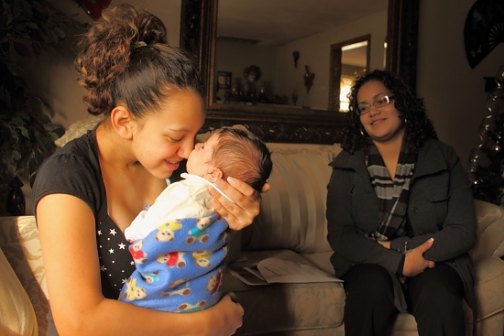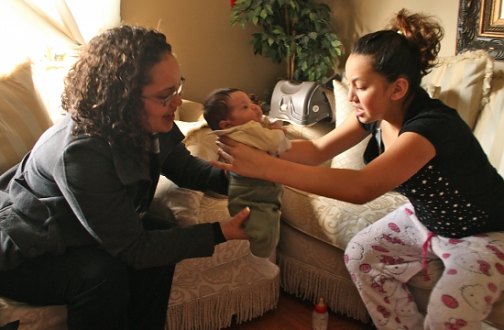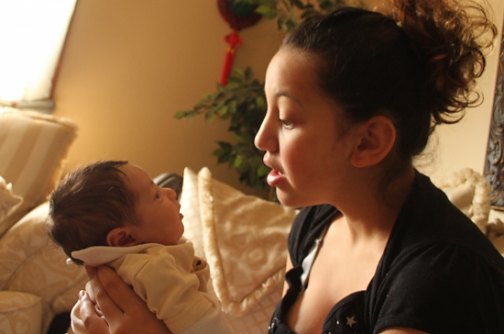Yanisha Claudio, 15, of Hartford, tenderly swaddled three-week-old Jordan, hoping he wouldn’t wake up. “He was crying until four o’clock in the morning,” said the weary Bulkeley High School freshman.

Tony Bacewicz photo
Yanisha Claudio, 15, cuddles her son, Jordan. Jennifer Colon of the Nurturing Families Network looks on.
It’s been a tough year for Claudio, whose boyfriend broke up with her after a trip to the emergency room confirmed she was more than five months pregnant. At home for now, Claudio juggles the demands of being a mother and a student with help from a daily tutor, a case worker who visits weekly, and the baby’s grandmother, a former teen mother herself.
“I never thought this would happen to me,” said Claudio. “I don’t know anything about being a mother.”
While teen pregnancy rates have declined nationwide and in Connecticut, statistics and interviews show an intergenerational cycle of children-bearing-children puts Hispanic teens in Connecticut at risk of giving birth once, or even twice, before their twenties.
Hispanic teen birth rates in Connecticut are 8.5 times higher than whites and almost double that of African Americans for girls ages 15 to 19. Of the 2,626 teen births in 2009, almost half – 1,277 – were to Hispanics, according to data from the state Department of Public Health.
Of the 22 births to teen moms ages 13 and 14, more than half – 12 girls – were to Hispanics. Nearly 15 percent of all teen births in the state were to girls who were already mothers. The rate was similar in 2008: of the 2,817 teen births, 1,364 were to Hispanic teens. Hispanics make up just 13 percent of the state’s population.
LISTEN TO FIRST PERSON: Candida Flores helps teen mothers.
To read related story on programs available to help teens click here.
In Connecticut, 84 percent of births to teen moms (ages 15 to 19) in 2009 were to low-income mothers enrolled in the publicly subsidized HUSKY or Medicaid health plans. The number of births to teens in these programs remains steady, immune to the declines statewide and nationally.
“We need to figure out what we are not doing, because what we are doing clearly isn’t working,” said Candida Flores, executive director of Family Life Education, a community-based agency in Hartford that assists pregnant and parenting teens. Flores, who had her first child at age 15, knows firsthand the challenges teen mothers face.
“Many of the girls we serve are in situations where pregnant teens are the norm,” she said. “Many are the daughters of teenage moms who are still struggling with their own issues. We end up helping both generations of mothers.”

Tony Bacewicz photo
Yanisha gives Jordan to Colon, who is there to help her care for her baby.
Advocates hope $6.4 million in federal funds targeting at-risk Hispanic and African American teens in Connecticut’s poorest cities, including New Haven, Hartford and Bridgeport, will make a difference by reaching youth at home, at school and in the community in ways that resonate with their culture and language.
But many experts say little will change until the state marshals the financial resources and political will to address the underlying issues of poverty, domestic violence, education achievement gaps, unemployment, health disparities, cultural nuances and lack of hope that impact Hispanic youth.
Complicating matters for Hispanic teens are language and cultural factors that research shows put Hispanics at greater risk of becoming parents, cited experts. These run the gamut from strictly defined gender roles and machismo, to religious beliefs that ban contraception and abortion, to the tendency for Hispanics to have older sexual partners.
“Cultural belief systems are difficult to change because they are rooted in centuries of traditions and customs,” said Dr. Raul Pino, acting director of Hartford’s Department of Health and Human Services.
Fast-growing Community, Multiple Needs
At 13 percent of the state’s population, Connecticut’s Hispanic community is growing at a dramatic rate – almost 50 percent during the past decade – while at the same time experiencing increasing social and health inequities.
Almost a third of Hispanic children ages 17 and younger live in poverty. Almost 22 percent of all Hispanics have no health insurance, leaving families with limited access to health care services. Connecticut’s Hispanics had the third highest unemployment rate in the nation among Hispanics in 2010, according to the Economic Policy Institute, a Washington, D.C. think tank. Hispanics had a four-year high school graduation rate of 64 percent in 2010, according to state Department of Education data.
Studies show teen parents are more likely to drop out of school and live in poverty, while babies born to teen parents are at a higher risk for low birth weight and infant mortality.
“All the indicators for Latinos in Connecticut point to a community in crisis,” said Werner Oyanadel, acting executive director of the state Latino and Puerto Rican Affairs Commission.

Tony Bacewicz photo
As a public health issue, teen childbearing cost state taxpayers at least $137 million in 2008 for public health care, child welfare, incarceration and lost tax revenue due to decreased earnings and spending, reports the National Campaign to Prevent Teen and Unplanned Pregnancy.
“People who don’t believe we should focus on teenage pregnancy because it’s the right thing to do should think about their wallets because society pays a price one way or another,” said Pino.
Connecticut’s changing Hispanic community has brought new challenges to neighborhood-based organizations that at times serve as surrogate families to newcomers. Once almost exclusively Puerto Rican, the Hispanic community has grown in the past 10 years to include Latin American immigrants from Mexico (now the state’s second largest Hispanic sub-group), the Dominican Republic, Guatemala, Ecuador, Peru, Columbia and other countries.
Research shows health status and behavior vary within Hispanic subgroups and the length of time they have lived in the United States.
Although everyone speaks Spanish, each sub-group “comes with their own beliefs and traditions” about sexuality, said Flores. Undocumented immigrants are among the most vulnerable.
“Many times these families live in isolation. The children don’t have an adult figure to guide them. They’re afraid or don’t know how to access resources.” Her agency takes a holistic approach.
“Many girls become invisible once they have their baby. People tell them to be good mothers. But what does that mean?” Flores said. “They need to understand that they are not bad mothers and that their teenage brains are still developing.”
Boys need special attention, too. The FatherWorks Program at the Village for Families & Children in Hartford helps fathers ages 15 to 24 to understand the “culture of conquest’’ that drives some males to “engage in risky sexual behavior’’ that lead to pregnancies with multiple partners, said Aldwin Allen, the program’s director. The agency has a federal grant to conduct a longitudinal study of its program. “We need to create a safe environment for these conversations to take place with men,’’ he said.
Self Esteem, Self Worth
The Department of Social Services (DSS) spends about $2 million a year on teen-pregnancy prevention programs in 13 communities where teen birth rates exceed the state average.

Tony Bacewicz photo
“These programs help teens develop self esteem and self worth so they can make better choices and see themselves outside of their community,” said LoriBeth Young, lead planning analyst with the Bureau of Aging, Community and Social Work Services at DSS.
“Teens living in limited communities often have a difficult time seeing their lives outside the few blocks they live in unless they are shown it’s possible. They don’t see themselves with bright futures.”
Jessica Valentin, 28, is a mother of four who had three children by age 20. Today, Valentin works as a certified nursing assistant and is a former peer facilitator at the M.O.M.S. program offered by The Hospital for Central Connecticut in New Britain – the same program that guided her when she became a teen mom.
“This program helped me grow into a strong, independent woman, able to care for my children and hopefully lead them in the right way so they won’t make wrong choices,” she said. “Teens get pregnant for many reasons. My mother was the greatest. But she was a single mom raising five children, so she was always working. I was lonely and looking for love and attention when I met the father of my children. I didn’t realize the consequences of my actions.”
Valentin said parents “need to be more open and start educating their children at an early age so they can think for themselves,” even if the conversations are difficult. “Sometimes girls get pregnant because they get raped. But people don’t talk about the abuse that takes place,” she said.
Community outreach remains the most effective way to reach teens, said Dr. Leticia Marulanda, director of Programs at the Hispanic Health Council in Hartford. She points to initiatives now underway that bring evidenced-based information and intensive personalized services directly to teens at home, in school-based health clinics and at community-based organizations. These initiatives call for cross-cultural training of outreach workers, educators and others.
In Hartford, a $4.5 million federally funded grant aims to cut the city’s teen pregnancy rate by 10 percent. Another $1.9 million in federal funding for the Support Pregnant and Parenting Teens program targets boys and girls in the five Connecticut cities with the highest teen pregnancy and high school dropout rates – Bridgeport, Hartford, New Britain, New Haven and Waterbury. These cities accounted for half of all teen births in 2009.
“We’re changing the message to teens from ‘you’ve been bad and need to redeem yourself’ to a more positive and empowering approach, with supports that help teens and their children move through this critical stage in their lives,” said Grace Damio, director of Research and Service Initiatives at the Hispanic Health Council, which is providing cross-cultural training and creating an online resource for parenting teens.
The high number of Hispanic births, noted Marulanda, is partly due to cultural and religious beliefs that discourage abortion. “Latinas tend to keep their pregnancies so their delivery numbers are higher,” she said.
Jennifer Colon, a home visitor with Nurturing Families Network (NFN), said teens like Yanisha Claudio are “among the lucky ones” because they have family support. “We see homes with child abuse and neglect where the state needs to intervene,” she said.
Teens comprise half of the 2,000 mothers in NFN, a statewide system that provides home visits, education and support to first-time, at-risk parents and their children for five years.
Some schools have support programs for teen mothers that include child care.
At Wilbur Cross High School in New Haven, teens can access parenting classes and a school-based health clinic while their children attend a licensed day care facility that keeps track of developmental milestones. The day begins early at the Elizabeth Celotto Child Care Center, as teens arrive with infants and toddlers in one arm and car seats and book bags in another.
“I’m in awe of these young ladies,” said Lorraine DeLuz, the center’ director. Last year, all but one of the center’s seniors graduated, and more than half were accepted to college and post-secondary school training programs.
Maria Damiani, director of Maternal Child and Family Health and Wellness for the New Haven Health Department, views school-based health clinics as the ideal vehicle for delivering reproductive health information and services to teens.
“School-based health clinics provide holistic care from nurse practitioners who know the kids,” she said. “It’s a safe and welcoming environment where students can talk honestly about what is going on in their lives.”
Hope Through Early Intervention
RoseAnne Bilodeau, executive director of Pathways/Senderos Center in New Britain, finds hope in the “army of feminists” among Hispanics in the teen-pregnancy prevention program.
“It’s outstanding to see what happens when girls who come from tough backgrounds believe they can do something with their lives and start channeling that energy,” said Bilodeau.
Among those finding her voice is Alondra Vasquez, a New Britain eighth-grader in the Pathways program.
“To be honest, I was thinking of having a baby when I was 14 or 15 because it’s the thing to do,” said Vasquez. “There’s a lot of pressure from girls and boys to have sex, but mostly boys who say they will beat you or leave you unless you have sex.” Learning about the realities of becoming sexually active at a young age changed her mind.
“Now I think I’ll wait until I have a good job and can take care of my baby,” she said.
EN PRIMERA PERSONA: Candida Flores ayuda a madres adolescentes.
To listen to WNPR’s report on this project click here.
Magaly Olivero wrote this story and helped produce the podcasts for C-HIT while participating in The California Endowment Health Journalism Fellowship, a program of the University of Southern California’s Annenberg School for Communication and Journalism.
Colleen Shaddox produced the podcasts for C-HIT.
Change the leadership in all of the organizations – public, and non-profit that are supposedly engaged to address this issue in the latino community. Whatever they are doing with the funding is obviously not working. Adorable baby. Unfortunately odds are already stacked against him.
Pingback: Teenage Girls Self Esteem Connecticut